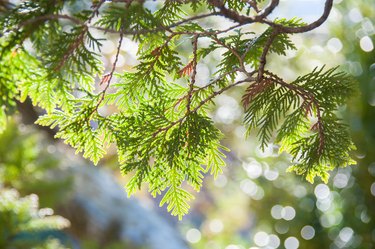
A surprising fact about cedar (Cedrus) is that there are only four species of cedar trees, and Michigan cedar trees (Thuja occidentalis) do not fit into the Cedrus category. What are commonly identified as cedar trees in North America are actually "false cedar," also known as both arborvitae, meaning "tree of life, as well as Northern White Cedar. This tree has the distinction of being the first North American tree to be transplanted from America to Europe in a reverse migration. Northern White Cedar is one of the longest-lived species in the State of Michigan. A stand of old-growth cedars estimated to be 500 years old still exists on Manitou Island.
Identifying Michigan’s Cedar Trees
Video of the Day
The four true species of cedar trees do not grow in North America. They are native to the Atlas Mountain range in Northwest Africa, the Island of Cyprus, Southwest Asia including Lebanon and Syria, and the Himalayan Mountain range. The Northern White Cedar is the only representative of its genus and family in Michigan and is one of five of the most common trees found in the northern state. Its leaves are flat and resemble overlapping green scales, and the fruit, or cone, is tiny, only about a half-inch long and pointing upward.
Video of the Day
Cedar forests in Michigan occupy about 6.5 percent of the forest area in the state, and about 70 percent of the volume is cedar, with about 30 percent of the trees growing outside the cedar forest, meaning that it's also found in other forest types such as northern hardwood, swamp hardwood and aspen forests. Its bark is red-brown to gray and fibrous with diamond-shaped patterns noticeable as the tree ages.
Cedar Tree Growth
Cedar tree growth can be described as a "will to live," as these trees can appear dormant for several years, then suddenly produce new growth. They like moist, wet soil but not earth that is drenched. When branches drop, new growth can evolve. Known as "vegetative layering," the live branch comes into contact with the right soil composition and roots are formed. While most cedars grow in swamp conditions, they won't survive in saturated earth.
The cedar tree drops its seeds in fall and winter, but not every year. Heavy leaf cover and thick moss can prohibit germination. Soil and moisture conditions impact growth, but overall, the cedar is rapid-growing. The biggest hindrance is the white-tailed deer, which has curtailed seedlings from maturing in many Northern Michigan forests. A dense cedar forest provides cover in the winter for deer and other wildlife, but summer conditions offer more food choices for animals, so the cedars are spared. Diseases from insects is minimal.
Distinguishing Between Cedars and Junipers
People often confuse juniper (Juniperus) with cedars, but there are significant, clearly visible differences. Cedars are pyramid shaped, while junipers have a pear-shape with a rounded midsection. Most junipers are used as shrubs, while cedars grow as trees in forests. Juniper berries, most often used in the production of gin, are actually seed cones.
A confusion between the two types of trees is the nomenclature. Juniperus virginiana is also known as the eastern red cedar, and Juniperus occidentalis, growing in the mountains of the west coast, are known as the western red cedar. At least six types of juniper have the word "cedar" as part of their names. Both cedars and junipers have fragrant wood that is resistant to rot, and both are evergreens. The leaves of the juniper feature three-sided leaves, while the cedar's leaves are flat. And you can't make good gin without the juniper berries, which cedars don't produce.
- Michigan State University: Forest Types of Michigan
- Tree Hugger: How to Identify and Manage Northern White Cedar
- Arbor Day: Eastern Red Cedar
- Detroit Free Press: 7 of Michigan’s Oldest Things Revealed
- USDA Plant Guide: Northern White Cedar
- North Dakota State University Extension Service: Questions on Cedar